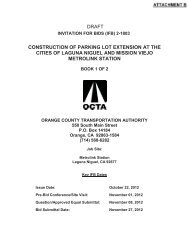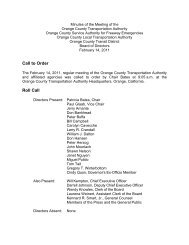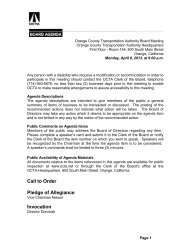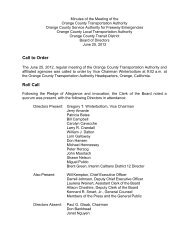here - Orange County Transportation Authority
here - Orange County Transportation Authority
here - Orange County Transportation Authority
You also want an ePaper? Increase the reach of your titles
YUMPU automatically turns print PDFs into web optimized ePapers that Google loves.
housing unit per 3.12 <strong>Orange</strong> <strong>County</strong> residents and one housing unit per 1.50 jobs by<br />
2020. A growing population requires approximately one housing unit per 3.28 residents<br />
or 1.5 jobs according to the Regional Planning Department at UC Berkeley. The<br />
projected housing production by 2020 will continue to satisfy the growing population.<br />
Given the forecast growth in population, this projected growth in housing is sufficient to<br />
house all the population of <strong>Orange</strong> <strong>County</strong> by 2020.<br />
Housing growth will occur throughout the <strong>County</strong> and t<strong>here</strong> will be fewer large areas<br />
without housing. The largest concentration of housing growth between 2008 and 2020<br />
will occur in Brea; the middle section of the <strong>County</strong> straddling the I-5 Freeway in Irvine;<br />
Tustin’s Legacy development; and Rancho Mission Viejo in unincorporated South<br />
<strong>County</strong>. Additionally, TAZs with 3,000 or greater housing units are expected to grow in<br />
numbers, signaling increased densification (see Figure 19).<br />
Overall, the <strong>County</strong> is projected to experience an even spread of housing unit growth<br />
between 2008 and 2020. During this time, the majority of TAZs will experience an<br />
increase of between 1-99 housing units. Figure 20 does show many TAZs that will<br />
experience no growth or loss of units that can be explained by the fact that much of<br />
<strong>Orange</strong> <strong>County</strong> developable land has already been built on and, t<strong>here</strong>fore, is limited in the<br />
number of units that can be added. This is especially true w<strong>here</strong> the housing stock is<br />
newer and/or within planned communities. It is likely that future developments will be<br />
more dense (likely multi-unit structures) to offset the limited land supply.<br />
<strong>Orange</strong> <strong>County</strong> housing unit density in 2020, measured in units per TAZ acre, shows<br />
pockets of increasing densification centered around all the transit options but mainly<br />
around the Metrolink rail line (see Figures 21 and 22).<br />
By 2035, housing totals in <strong>Orange</strong> <strong>County</strong> are projected to grow to 1,174,912. This<br />
constitutes an increase of 74,652 units between 2020 and 2035. In 2035, the only TAZs<br />
with no housing units are areas of permanently dedicated open space and parkland. The<br />
densest TAZs, holding 3,000 housing units or more, become much more prevalent in<br />
2035 and are most notably found in Brea, Fullerton, Anaheim, Tustin, Irvine, Lake<br />
Forest, Newport Beach, San Juan Capistrano, Yorba Linda, and unincorporated south<br />
county communities of Ladera Ranch and Rancho Mission Viejo (Figure 23).<br />
As shown in Figures 24 and 25, from 2020 to 2035, the majority of high-growth TAZs<br />
which grow by 1,000 units or more and by 100% or more, effectively double the housing<br />
units in those areas. These include TAZs in Anaheim, La Habra, <strong>Orange</strong>, Fullerton,<br />
Irvine, Tustin, and the future Rancho Mission Viejo community in unincorporated South<br />
<strong>County</strong>.<br />
31














